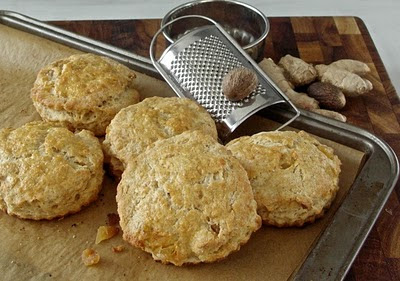WHOLE-WHEAT GINGER SCONES
(from Sarabeth Levine)
Makes approximately 16 scones
Makes approximately 16 scones
¾ cup plus 1 tablespoon whole milk
2 large eggs, chilled
Seeds of 1 vanilla bean
1 1/2 cups unbleached all-purpose flour, plus more as needed
1 1/2 cups whole-wheat stone ground flour
1 tablespoon plus 1 3/4 teaspoons baking powder
3 tablespoons superfine sugar
1/2 teaspoon fine sea salt
A few gratings of fresh nutmeg
10 tablespoons (1 ¼ sticks) unsalted butter, chilled and cut into ½-inch cubes
1/3 cup (3 ounces) crystallized ginger, diced into 1/4-inch pieces
1 large egg, well beaten with a hand blender, for glazing
1. Position a rack in the center of the oven and preheat to 425°F. Line a half-sheet pan with parchment paper.
2. TO MAKE THE DOUGH BY HAND: Whisk the milk, 2 eggs , and vanilla seeds together in a small bowl; set aside. Sift the flours, baking powder, sugar, salt, and nutmeg into a medium bowl. Add the butter and mix quickly to coat the butter with the flour mixture. Using a pastry blender, cut the butter into the flour, scraping the butter off the blender as needed, until the mixture resembles coarse bread crumbs with some pea-size pieces of butter. Mix in the ginger. Using a wooden spoon, stir in the milk mixture and mix just until the dough clumps together.
TO USE A MIXER: Whisk the milk, 2 eggs, and vanilla seeds together in a small bowl; set aside. Sift the dry ingredients together into the bowl of a heavy-duty stand mixer. Add the butter. Attach the bowl to the mixer and fit with the paddle attachment. Mix on medium-low speed until the mixture looks mealy with some pea-size bits of butter. Mix in the ginger. Reduce the mixer speed to low. Add the milk mixture, mixing just until the dough barely comes together.
3. Turn the dough out onto a well-floured work surface and sprinkle about 2 tablespoons of flour on top. Knead the dough a few times, just until it doesn’t stick to the work surface. Do not overwork the dough. The surface will be floured, but the inside of the dough should remain on the wet side. Gently roll out the dough into a ¾-inch-thick round.
4. Using a 2 1/4-inch biscuit cutter, dipping the cutter into flour between cuts, cut out the scones (cut straight down and do not twist the cutter) and place 1 ½ inches apart on the prepared half-sheet pan. To get the most biscuits out of the dough, cut out the scones close together in concentric circles. Gather up the dough scraps, knead very lightly, and repeat to cut out more scones. Brush the tops of the scones lightly with the beaten egg, being sure not to let the egg drip down the sides (which would inhibit a good rise).
5. Place the scones in the oven and immediately reduce the heat to 400°F. Bake until golden brown, about 18-20 minutes. Cool on the pan for a few minutes, then serve warm or cool completely.

Tidak ada komentar:
Posting Komentar